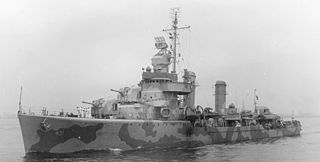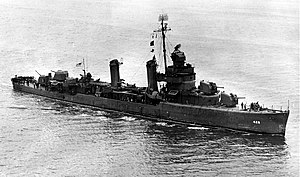
USS Dickerson (DD-157) was a Wickes-class destroyer in the United States Navy, and was converted to a high-speed transport at Charleston, South Carolina and designated APD-21 in 1943. She was named for Mahlon Dickerson (1770–1853), Secretary of the Navy from 1834 to 1838.

USS Du Pont (DD–152) was a Wickes-class destroyer in the United States Navy during World War II, later reclassified as AG-80. She was the second ship named for Rear Admiral Samuel Francis Du Pont.

USS Livermore (DD-429), a Gleaves-class destroyer, was the 1st ship of the United States Navy to be named for Samuel Livermore, the first naval chaplain to be honored with a ship in his name.

USS Plunkett (DD-431), a Gleaves-class destroyer, is the only ship of the United States Navy to be named for Rear Admiral Charles Peshall Plunkett.

USS Kearny (DD-432), a Gleaves-class destroyer, was a United States Navy warship during World War II. She was noted for being torpedoed by a German U-boat in October 1941, before the U.S. had entered the war. She survived that attack, and later served in North Africa and the Mediterranean.

USS Woolsey (DD-437), a Gleaves-class destroyer, was the second ship to be named Woolsey in the United States Navy. It is the first to be named for both Commodore Melancthon Brooks Woolsey and his father Commodore Melancthon Taylor Woolsey.

USS Ludlow (DD-438), a Gleaves-class destroyer, was the third ship of the United States Navy to bear the name. The second and third Ludlow ships were named for Lieutenant Augustus C. Ludlow, second in command of USS Chesapeake. He was, like his captain, mortally wounded in their ship's engagement with HMS Shannon on 1 June 1813, and died at Halifax, Nova Scotia on 13 June.

USS Edison (DD-439), a Gleaves-class destroyer, was the first ship of the United States Navy to be named for Thomas Alva Edison, an inventor and businessman who developed many important devices and received the Navy Distinguished Service Medal for his contributions to the Navy during World War I. Edison was one of the few U.S. Navy ships to be named for a civilian.

USS Ericsson (DD-440), a Gleaves-class destroyer, was the third ship of the United States Navy to be named after John Ericsson, who is best known for devising and building the Civil War ironclad USS Monitor.

USS Wilkes (DD-441) was a Gleaves-class destroyer commissioned in the United States Navy from 1941 to 1946. After spending several decades in the reserve fleet, the destroyer was scrapped in 1972.

USS Nicholson (DD-442), a Gleaves-class destroyer, was the third ship of the United States Navy to be named for the Nicholson family, which was prominent in the early history of the Navy. The destroyer saw service during World War II in the Atlantic, Mediterranean and Pacific theaters. Following the war, the ship was placed in reserve and used as a training ship. In 1951, the destroyer was transferred to Italy and renamed Aviere. In service with the Marina Militare until 1975, Aviere was sunk as a target ship in 1975.

USS Niblack (DD-424), a Gleaves-class destroyer, is the only ship of the United States Navy to be named for Albert Parker Niblack. Niblack became the Director of Naval Intelligence 1 March 1919, and Naval Attache in London 6 August 1920. As vice admiral, he commanded U.S. Naval Forces in European waters from 15 January 1921 to 17 June 1922.

USS Benson (DD-421) was the lead ship of her class of destroyers in the United States Navy during World War II. She was named for Admiral William S. Benson (1855–1932).

USS Mayo (DD-422) was a Benson-class destroyer in the United States Navy during World War II. She was named for Admiral Henry Thomas Mayo.

USS Madison (DD-425) was a Benson-class destroyer in the United States Navy during World War II. She is the third Navy ship of that name, and the first named for Commander James J. Madison (1888–1922), who was awarded the Medal of Honor during World War I.

The second USS Lansdale (DD-426) was a Benson-class destroyer in the United States Navy during World War II. She was named for Philip Lansdale.

USS Hilary P. Jones (DD-427) was a Benson-class destroyer in the United States Navy during World War II. She was named for Admiral Hilary P. Jones.

USS Laub (DD-613) was a Benson-class destroyer in the United States Navy during World War II. She was the second ship named for Henry Laub, who was killed during the Battle of Lake Erie in 1813.

USS Herbert C. Jones (DE-137) was an Edsall-class destroyer escort built for the U.S. Navy during World War II. She served in the Atlantic Ocean and provided destroyer escort protection against submarine and air attack for Navy vessels and convoys.

HMS Brecon was a Hunt-class destroyer of the Royal Navy that saw service in the Second World War, one of two ships in the fourth subgroup of the class, built to a radically different design from other ships in the Hunt class.





















